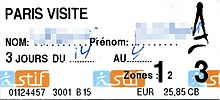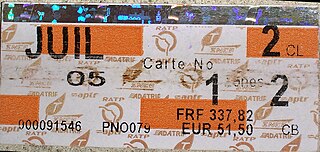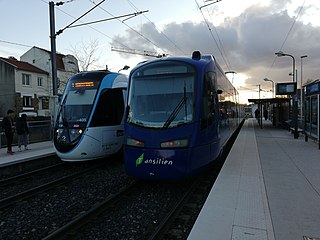
The Paris Visite is a discount travel card aimed mainly at tourists visiting Paris for a few days.

The Paris Visite is a discount travel card aimed mainly at tourists visiting Paris for a few days.
The pass can be bought for 1, 2, 3 or 5 consecutive days for public transport zones 1-3 or 1-5 (includes airport transport). [1] [2] [3]
Once purchased, it allows free travel on the Paris Métro, RER and Transilien trains (within the chosen fare zones), Buses (both the RATP bus network, which covers Paris and its near suburbs, and the Optile network, which covers the wider Grande couronne area), Trams, and the Montmartre funicular. [2] [3]
Zones 1 to 3 will cover most tourists who intend to spend most time in the city centre. For more out-of-town destinations, a ticket covering the banlieue (English: suburbs) may be better value. These tickets also cover travel on the Roissybus and the Orlyval to and from the two main Paris airports, Paris Orly and Charles de Gaulle Airport.
The local transport authority (STIF) has systematically reduced the number of fare zones, and from mid-July 2011 the STIF combined that with Zone 5. [4] [5]

The Paris Métro, operated by the Régie autonome des transports parisiens (RATP), is a rapid transit system in the Paris metropolitan area, France. A symbol of the city, it is known for its density within the capital's territorial limits, uniform architecture and unique historical entrances influenced by Art Nouveau. The system is 226.9 kilometres (141.0 mi) long, mostly underground. It has 308 stations of which 64 have transfers between lines. There are 16 lines, numbered 1 to 14, with two lines, 3bis and 7bis, named because they started out as branches of Line 3 and Line 7, respectively. Line 1, Line 4 and Line 14 are automated. Lines are identified on maps by number and colour, with the direction of travel indicated by the terminus.

Orlyval is a light metro shuttle service at Paris's Orly Airport using the Véhicule Automatique Léger driverless, rubber-tyred people mover technology. The line, which opened on 2 October 1991, offers free service between the two airport terminal stations, and premium fare service to Antony station, where passengers can connect to the city's RER B trains. Orlyval is the second line to use the VAL technology after the Lille Metro and the first airport people mover system to use VAL.

The Travelcard is an inter-modal travel ticket for unlimited use on the London Underground, London Overground, Elizabeth line, Docklands Light Railway, London Trams, London Buses and National Rail services in the Greater London area. Travelcards can be purchased for a period of time varying from one day to a year, from Transport for London, National Rail and their agents. Depending on where it is purchased, and the length of validity, a Travelcard is either printed on a paper ticket with a magnetic stripe or encoded onto an Oyster card, Transport for London's contactless electronic smart card, or an ITSO smartcard issued by a National Rail train operating company. The cost of a Travelcard is determined by the area it covers and, for this purpose, London is divided into a number of fare zones. The Travelcard season ticket for unlimited travel on London Buses and the London Underground was launched on 22 May 1983 by London Transport. One Day Travelcards and validity on other transport modes were added from 1984 onwards. The introduction of the Travelcard caused an increase in patronage and reduced the number of tickets that needed to be purchased by passengers.

The carte orange was a pass for the public transportation system in Paris and the surrounding Île-de-France region. A holder of the pass was entitled to unlimited use of the public transit system within a given period of time, with Cartes oranges being available for durations of one week or one month. The carte orange was discontinued in February 2009, and replaced by Navigo semaine and Navigo mois on a Navigo card.

The Navigo pass is a family of contactless smart cards that can be used for payment in public transportation in Paris and the Île-de-France region. It was first introduced on 1 October 2001. The cards are implemented as contactless smart cards using the Calypso standard, initially with Radio-frequency identification (RFID), then Near-field communication (NFC) since 9 December 2013, and enables authenticated access at turnstiles by scanning the card at an electronic reader. Cards can be loaded with tickets and passes at staffed counters and at ticket vending machines. Since July 2018, they can also be recharged directly using a smartphone. Certain Android smartphones can be used in place of Navigo passes using the Île-de-France Mobilités app, allowing validation at Navigo card readers using NFC functionality.

Paris is the centre of a national, and with air travel, international, complex transport system. The modern system has been superimposed on a complex map of streets and wide boulevards that were set in their current routes in the 19th century. On a national level, it is the centre of a web of road and railway, and at a more local level, it is covered with a dense mesh of bus, tram and metro service networks.
Paris Métro Line 11 is one of the sixteen lines of the Paris Métro. It links Châtelet to Mairie des Lilas in the northeastern suburbs. At a length of 6.3 km and 13 stations served, it is currently the shortest of the 14 main Métro lines but is being extended by 6 stations. With 47.1 million riders in 2017, it is the thirteenth busiest line in the network.
Île-de-France Mobilités is the governmental authority (EPA) that controls and coordinates the different companies operating the Paris-area public transport network and the rest of the Île-de-France region. In this capacity, it issues operating contracts for the various services, owns the buses and rolling stock used on those services, and acts as the main financing body for transport projects in the region. It coordinates the operation of RATP Group, SNCF, and the nearly 90 Optile-affiliated bus companies.

Noctilien is the night bus service in Paris and its agglomeration. It is managed by the Île-de-France Mobilités, the Île-de-France regional public transit authority, and operated by RATP and Transilien SNCF.

The RATP bus network covers the entire territory of the city of Paris and the vast majority of its near suburbs. Operated by the Régie Autonome des Transports Parisiens (RATP), this constitutes a dense bus network complementary to other public transport networks, all organized and financed by Île-de-France Mobilités.

The Ticket t+ is the standard single trip ticket for Paris public transit. It can be bought from ticket machines or staffed counters, but not on board buses. As of 2024, it is available as a single paper ticket at the price of €2.15. Since 2019, the ticket can also be loaded onto a reusable Navigo Easy card, which can be purchased for €2 at staffed ticket counters and select ticket vending machines. When using Navigo Easy, the ticket is also available as a pack of 10 at a reduced price of €17.35. Starting 2021, Île-de-France Mobilités is in the process of phasing out the use of paper tickets, and as of September 2023 has discontinued offering a carnet discount for paper tickets. A reduced-price carnet is available for children under 10 years old and some other groups for €8.65.

The Montmartre Funicular is an inclined transport system serving the Montmartre neighbourhood of Paris, France, in the 18th arrondissement. Operated by the RATP, the Paris transport authority, the system opened in 1900; it was entirely rebuilt in 1935 and again in 1991.

Île-de-France tramway Line 4, also called the T4, is an 13.3-kilometre (8.3 mi) long tram-train line in the Seine-Saint-Denis department of Île-de-France. The line starts at Aulnay-sous-Bois and features two branches, with the first running to Bondy and the second running to Montfermeil.

Voguéo was a water taxi service operated on the rivers Seine and the Marne in the Île-de-France.

The Batobus is a boat service along the River Seine in the Paris region, with nine stops. The name is a trademark of Bateaux Parisiens. In 2006 –2007, it carried 843,000 passengers.
In France, the versement transport is a hypothecated urban regional payroll tax levied on the total gross salaries of all employees of companies of more than 11 employees, originally intended to raise capital for investment in local public transport infrastructure, but more and more used to cover its operating expenses. The tax is levied on the employer, not the employee directly. The money is directed to the autorité organisatrice de transport urbain, the local government authority responsible for organising public transport.
Public transport fares in the Île-de-France are set using a system of concentric fare zones radiating from central Paris, and are implemented with a mixture of paper and electronic tickets. Prices are determined by Île-de-France Mobilités, the regional autorité organisatrice de transports. As of January 2024, single tickets within Paris cost €2.15, and monthly passes covering all fare zones cost €86.40.
The Carte Améthyste is an annual season ticket for the elderly and disabled. It allows free second-class transport in the Île-de-France on all services provided by the RATP and the SNCF.

Grand Paris Express is a group of new rapid transit lines being built in the Île-de-France region of France. The project comprises four new lines for Paris Métro, plus extensions of existing Lines 11 and 14. A total of 200 kilometres (120 mi) of new track and 68 new stations are to be added, serving a projected 2 million passengers a day.

Île-de-France tramway Line 5 is part of the modern tram network of the Île-de-France region of France. Line T5 connects the centre of Saint-Denis and Garges - Sarcelles station, in the Northern suburbs of Paris. Line T5 was Île-de-France's first rubber-tyred tramway line. The line has a length of 6.6 km (4.1 mi) and 16 stations. It opened to the public on 29 July 2013.